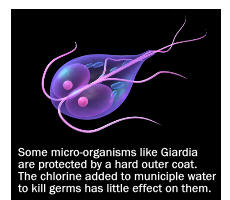Giardia Lambia
Giardia lamblia is a single-celled animal, a.k.a. Giardia inestinalis. It is a protozoan and an intestinal parasite.
In one form it is a Cyst, or inactive form, which is produced by the trophozite (below) in the intestine. It has a highly resistant “shell” which allows it to live outside the body and infect others. When ingested, it is activated by stomach acid and produces disease-causing trophozites. The Trophozite, or active form, is teardrop-shaped and attaches to the intestinal wall. It is released from the cyst form (above) to cause disease. The Trophozite cannot live long outside the body.
In size, the the Cyst form can be as small as 7 microns.
 |
|---|
Giardia occurs worldwide and is found in the feces of infected animals (including humans). It can also be on the surface of uncooked foods contaminated with feces.
In water, it occurs in natural water supplies as well as hot tubs, swimming pools, water parks, and ice.
According to Water Technology magazine, the health effects and treatment are
- Causes giardiasis, also called “beaver fever” or “traveler’s diarrhea.” Very common: Up to 2.5 million cases occur annually in the United States. Potentially life-threatening to infants. Some adults develop immunity or never show symptoms.
- Symptoms: Begin one to two weeks after becoming infected: diarrhea, stomach or abdominal cramps, nausea. Can lead to weight loss and dehydration.
- Treatment: Selected prescription drugs.
Giardia is regarded as a "primary contaminant" under the Safe Drinking Water Act, and EPA sets the MCLG (Maximum Contaminant Level Goal) at zero. Under federal law, public water supplies must show removal or inactivation of Giardia to at least the three-log (99.9 percent) level.
Treatment. Regular chlorination is not effective, but shock chlorination can be used to treat giardia. NSF/ANSI certification is available for filters that remove all particles 1 micron and larger. This includes ultrafiltration and tight carbon block filters. Ultraviolet is very effective at treating Giardia, as are reverse osmosis and ozone.
Sources: US Centers for Disease Control and Prevention, MedicineNet.com, US Food and Drug Administration, Water Technology®archives.Water Technology Volume 32, Issue 5 - May 2009.